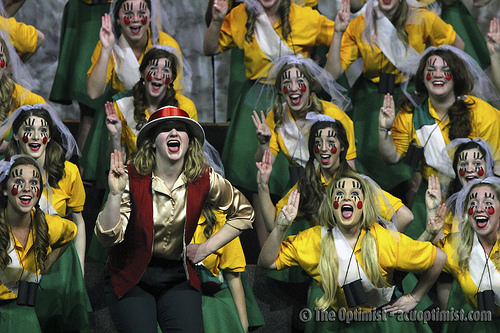Sing Song is one of ACU’s biggest traditions, combining singing, choreography and costumes in a competition that consumes campus for five weeks. Sing Song has many memorable components but one of the most important aspects of the competition is the expression that has come to define the show, commonly known as the Sing Song face.
Tom Craig, director of student productions, said the traditional Sing Song make-up (painted eyelashes and rosy cheeks), began appearing in the late 1960s and has become one of the most recognizable features of the show.
Gabe Guerra, junior psychology major from Edinburg said, “Overestimating the importance of the Sing Song face is impossible.”

The women of Ko Jo Kai pop a Sing Song face. (Optimist photo by Deanna Romero)
“The Sing Song face is Sing Song,” Guerra said, and he explained that the face should feel unnatural and is not designed to look happy, but frightening.
Guerra advises a three-step process for making the Sing Song face beginning with opening your eyes as wide as possible (if they don’t feel like they’re protruding, “you’re not doing it right”), lifting the eyebrows and finally opening the mouth as wide as possible.
Craig has a slightly more conservative view of the Sing Song face, believing it is not essential for an act’s success but, “serve[s] as a tool to help each group focus for the task at hand.”
The Sing Song face is just one of many ways Sing Song has changed over the years. Since its founding in 1957, Sing Song has evolved from a largely choral performance to a complex show with many components.
Craig credits the introduction of basic choreography in the 1969 freshman act for starting the evolution.
“The paradigm shifted from choral groups performing on stage to performers entertaining on stage,” Craig said.
Bob Hunter, who founded Sing Song in 1957, is continually astounded by how Sing Song has evolved and thinks the tradition will continue to evolve and grow in the future because of student involvement.
“The sky’s the limit,” said Hunter, senior vice president emeritus, “because students have great concepts about how to develop their own ideas, projects and programs.”

